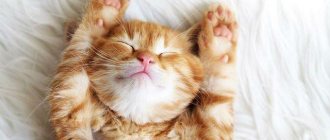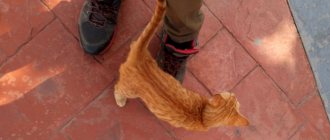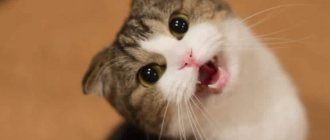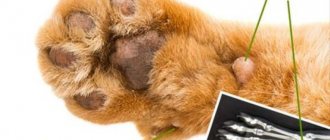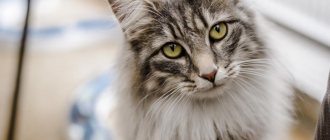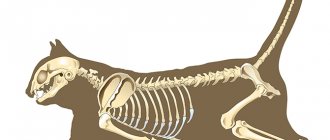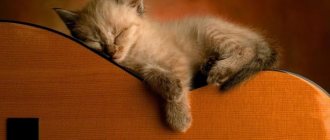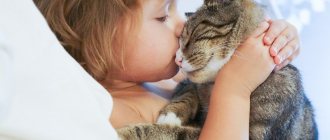| Article verified by a practicing veterinarian |
One of the features of cats for which we love them so much is the ability to make a quiet guttural bubbling sound called a purr.
They purr when they feel good, happy and comfortable; they purr as a sign of support in moments of intimacy with a person. But sometimes a cat's purring can mean stress, fear, nervousness, or even illness. Let's figure out why cats purr and wring their paws, when purring is a sign of joy, and when the owner should be wary and take the pet to a specialist.
For what reasons does a cat purr?
When answering why cats purr, many owners confidently say that the reason lies in positive emotions. This answer is correct, but incomplete. Sometimes purring is also triggered by negative emotions. You can only understand your pet's desires over time by remembering the difference in volume, duration and frequency of sounds.
Positive emotions
The ability to make a vibrating sound appears in kittens on the 2nd day after birth.
This is necessary to communicate with the mother. The purring of the babies indicates their satiety and good health, and the sounds emanating from the mother cat confirm the safety of her offspring.
In the wild, light vibrations are not detected by other predators, but are clearly perceptible to parents located at a long distance. This helps protect the litter until it becomes independent.
Among the positive emotions that awaken purring are:
- greeting the owner or communicating with other animals;
- going to bed before bed;
- gratitude for the treat or affection received;
- attracting the opposite sex;
- trying to beg for something tasty;
- interest in some object (delicious food) or object (a bird outside the window).
According to one version, cats purr to prevent muscle diseases that threaten them due to too much sleep. Vibrations spreading throughout the body have a positive effect on ligaments, bones and muscles, helping to reduce the load on the musculoskeletal system.
Negative emotions
Purring also occurs when a furry pet is under stress. The vibrations help him stabilize his blood pressure and bring his pulse back to normal.
Sometimes the reason lies in illness. Purring is a physiological pain reliever. It speeds up metabolism and promotes rapid regeneration. Try to observe how a cat purrs after sterilization: the frequency and volume of the sound will differ from usual until the end of rehabilitation.
One of the possible complications of coronavirus infection is feline infectious peritonitis. Its alternative name is “purring disease.” Due to damage to the blood vessels, some of the fluid enters the peritoneum and lungs, causing peritonitis. The bloating that appears is accompanied by a characteristic purring sound.
Also, mustachioed pets purr when their owner strokes them incorrectly or when a more formidable opponent tries to scare them. In the second case, they demonstrate their defenselessness, trying to avoid a possible fight.
How the purring mechanism is started
Scientists do not fully understand how cats purr. The vocal cords are responsible for the sound, but vibration is explained by more interesting reasons.
Physiological features
The most popular theory to explain how cats purr is the one that focuses on the hyoid bones. In domestic animals they take the shape of a triangle, and in wild animals they take the shape of a rectangle. Because of this, wild feline predators are rarely found purring.
Everything is easier with sound. It passes through the animal's nose and mouth. The heart and lungs at this moment cannot be listened to.
What is known for certain about vibrations is that they appear based on a signal from the brain. When receiving positive and negative emotions, it sends neurons to the responsible organ. This helps to guess what cats purr about.
Unproven facts
When discussing how cats purr from a physiological point of view, we take as a basis the muscles located behind the vocal cords. Their contraction leads to vibration of the hyoid bones, spreading throughout the body. This theory is the most popular, but there are several others. They explain that purring occurs through:
- Lungs
. A purring pet is the result of the work of the diaphragmatic and intercostal muscles. It is assumed that during the breathing process they create sound vibrations of different amplitudes. This is the least popular theory, since the intensity of the purring does not change with inhalation and exhalation.
- False ligaments
. They are located directly above the vocal cords and look like a bunch of elastic membranes. According to this theory, sound vibrations appear due to changes in pressure in the circulating bloodstream. This causes the chest to vibrate and transmit sound to the sinuses.
The hyoid bone theory is more convincing. This is confirmed by the absence of purring in cats with laryngeal paralysis.
Cat purring - real sound therapy
We have already mentioned that cats often lie down on the owner’s sore spot and begin to purr. An animal can, for example, lie on the owner’s legs if they are “whining” about the weather. Or even lie on your head when the owner is tormented by a migraine. What does this mean, can pets really heal? It turns out that the purring of cats is therapeutic sound therapy.
Photo: Scottish Fold kitten | Dreamstime.com
A measured, quiet sound calms frayed nerves no worse than the sound of rain or the sound of a babbling stream. Felinologists believe that cats, with the help of special rumbling sounds, can treat the following ailments:
- Bone fractures, joint and muscle pain;
- Nervous disorders (depression, stress);
- Reduced immunity;
- Arterial hypertension;
- Diseases of the heart and blood vessels;
- Various inflammatory processes;
- Diseases of the stomach and/or intestines;
- Respiratory ailments.
Even though the sounds of rumbling help relieve, for example, joint pain or lower blood pressure, such sound therapy cannot be considered a full-fledged treatment; you will still need the help of a doctor. However, a cat's purring fights well against the same fatigue and nervousness.
Which other member of the cat family can purr?
Once you understand how cats purr, it is not so difficult to understand which of their wild relatives is capable of emitting similar sound vibrations. Large cats differ not only in the shape of the hyoid bone, but also in the elasticity of the ligaments. Only the group of small cats has the most flexibility: cheetahs, ocelots and lynxes; they can make purring sounds.
Despite physiology, there are exceptions. Purring large predators include snow leopards, pumas, clouded leopards and leopards. Given the structure of the larynx, their ability is a real mystery.
Where does the sound come from?
For a long time, zoologists could not determine why cats purr and how such sounds are produced, because animals do not have a special organ responsible for their creation. It turned out that in certain situations the brain sends an electrical impulse to the muscles that hold the vocal cords. As a result, the bones located in the area between the root of the tongue and the skull begin to vibrate. The mouth and nose are involved in creating rumbling. Moreover, the sound is produced both on exhalation and on inhalation. The vibration takes over the whole body.
Not only pets can purr, but also large wild representatives of the cat family. But with them it looks like a quiet roar. Scientists believe that the vibrations created by purring have a beneficial effect on the condition of the animal’s body, calm it down, and help heal from diseases of the digestive tract and urinary system.
Cat-human interaction
The way a cat purrs depends on the person. A purring pet can trample its paws on its owner, lie down on top or next to it. All these actions have their explanation.
Showing affection
If you stroke your mustachioed pet, he will soon begin to purr. This means that he enjoys touch and communication with a person. When stroking against the grain or by a stranger, you can see the opposite effect. The animal will be angry or frightened and will hasten to leave with a threatening hiss.
Foot trampling
The most popular interpretation of trampling is the “milk step”. Kittens make similar movements on their mother's chest, stimulating the faster production of milk. Fingering with paws is also associated with:
- showing gratitude and demonstrating trust in a person;
- unrealized sexual instinct in castrated animals;
- treating the owner or relieving one’s own stress;
- preparing a comfortable place to sleep.
If your pet releases its claws when trampling, do not scold it. He does not control this action, so pet him and place a thick blanket or pillow under his paws.
Lying on or next to a person
Lying nearby is the highest form of trust and love. The animal feels safe with its two-legged owner. If a person is unwell, a furry pet can lie on top, sending its healing vibrations to the sore spot.
Why don't some cats purr?
Non-purring breeds include Ragdolls and Devon Rex, as well as overly phlegmatic pets. If a healthy cat does not purr, like its relatives, then everything is fine with it. This feature is inherited.
If lethargy, rapid heartbeat, dry nose or shortness of breath appear, the animal should be seen by a doctor. Damage to the “rumbling” occurs in diseases of the respiratory system.
Also, the reason for the lack of purring can be stress or a bad mood of the owner. Relaxing in the arms of a tense person is not so easy.
What does the purring of a cat mean?
Not long ago, British scientists began to use sound therapy, namely the purring of cats in recordings. This is done so that astronauts who arrive on earth after a long stay in space can quickly adapt. It is purring that helps restore muscle and bone tissue.
Accordingly, there can be a huge number of reasons why a cat purrs. Actually, the same as a person’s laughter or tears. A person can laugh and cry with happiness. In the same way, a cat purrs when it is happy or vice versa when it feels anxious. It has been noted that cats can purr when they are hungry, feel anxious or are afraid of something.
The cat purrs
Benefits of “cat songs”
“Cat songs” are useful not only for their authors, but also for listeners. They are helping:
- normalize the emotional state, which is especially useful for owners with nervous disorders;
- strengthen bone tissue and reduce pain;
- improve blood circulation in the brain;
- lower blood pressure or pulse that is too high;
- enhance the regeneration of tissues of the gastrointestinal tract;
- reduce the likelihood of stroke and heart attack.
People who live with furry pets live 4.5 years longer than those who do not have pets. There is also a relationship with allergen resistance. Children who live with a mustachioed pet from birth are less susceptible to respiratory diseases and rarely suffer from asthma.
